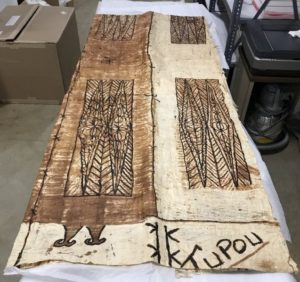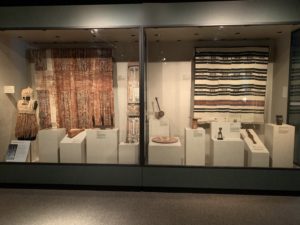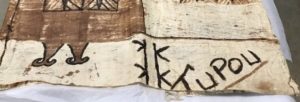
Our Tongan bark cloth (ngatu) being prepared for display in the McClung’s Decorative Arts gallery. Ngatu, c. 1986, Neiafu, Vava’u, Tonga, Gift of Jeff Chapman, 1986.6.1.
We recently wrote about a new installation of Oceanic and African objects in our Decorative Arts gallery. Today, I’d like to profile two of my favorite objects in that display.
Bark cloth is a versatile textile used across Oceania, Africa, and Asia and made from, as its name suggests, the bark of trees. This “cloth without weaving” is known by different names in each of its locales. In Tonga, where our example of bark cloth was created, it’s known as ngatu. The cloth is used in everyday and ceremonial contexts and is made in all shapes and sizes. Ngatu are given as symbols of respect and wealth, and are used as floor mats, clothing, and as gifts at funerals and weddings. Amazingly, our ngatu has never been on display until our recent installation.

Our new Oceania and Africa case displays in Decorative Arts. The ngatu and ipe can be seen in the display at left.
Made from the soaked and beaten inner bark of the Hiapo, or Mulberry tree, the cloth is made by women. After young paper mulberry trees are harvested, their inner bark is stripped, and then soaked and beaten on a special semi-circular table using a wooden mallet known as an ipe. The beating of the bark makes a musical and rhythmic sound familiar to Tongans, and the grooves on the ipe help the user beat the bark paper thin. Our ipe (wooden mallet) was made by Sefo Halalilo.

Bark Cloth Pounder (Ipe), c. 1986, Sefo Halalilo (Dates unrecorded), Tonga, Vava’u, Tuanekivale, Wood, Gift of Jeff Chapman, 1986.6.1.
The thin pieces of cloth are then glued together and laid over the table so that designs known as kupesi can be applied. The designs are woven into special coconut fiber mats. The kupesi mats are then colored with brown-reddish dye made from plant pigments or clay soil, and then the designs are imprinted on the bark cloth. The resulting cloth may then be hand-painted and the finished cloth is left to sun dry. The video below goes into great detail on the process.
Additional research is needed, but we believe that part of the pattern on the ngatu is likely an older kupesi design known as “Tokelau (north) Feletoa (the village of Feletoa)” said to have originated from the village of Feletoa, in the Vava’u Group located to the north of Tongatapu.
The “Tupou” text visible in the image of the ngatu probably refers to the common family name Tupou, or else to the long line of kings and queens in the Tongan monarchy by the name of Tupou.

We are thrilled to have this important part of Tongan culture prominently on display.
Additional Resources
- Google Arts & Culture, Ngatu, Cultural Wealth of the Kingdom of Tonga
- RISD Museum Exhibition, Cloth Without Weaving : Beaten Barkcloth of the Pacific Islands
